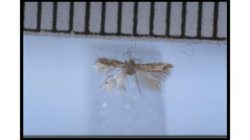Biology:Stigmella ilsea
| Stigmella ilsea | |
|---|---|

| |
| Male holotype | |
| Scientific classification | |
| Domain: | Eukaryota |
| Kingdom: | Animalia |
| Phylum: | Arthropoda |
| Class: | Insecta |
| Order: | Lepidoptera |
| Family: | Nepticulidae |
| Genus: | Stigmella |
| Species: | S. ilsea
|
| Binomial name | |
| Stigmella ilsea Donner & Wilkinson, 1989[1]
| |
Stigmella ilsea is a moth of the family Nepticulidae.[2] It is endemic to New Zealand and has been observed in the North and South Islands. The larvae of this species are leaf miners and feed on Olearia virgata, Olearia rugosa, Olearia odorata, Olearia laxiflora, Olearia lineate and Olearia hectorii. The mine starts as very narrow gallery, but the full-grown larva occupies all space between the cuticles, leaving nothing but a small, empty bladder. Larvae have been recorded from February to May and in July and September. The cocoon is pale brown and is spun in detritus on the ground underneath the host plant. Adult moths have been recorded in January, October and November. Reared specimens emerged from July to September. There is likely one generation per year.
Taxonomy
This species was first described in 1989 by Hans Donner and Christopher Wilkinson from specimens collected in Taupō and Otago.[3] The male holotype specimen, collected at Whenuakura flats at Whanganui Valley in the Taringamotu State Forest at an altitude of 792 m on the 11 October 1979 by J. S. Dugdale, is held in the New Zealand Arthropod Collection.[3]
Description
The larvae are 2–3 mm long and pale yellow.[3]
Donner and Wilkinson described the adult male and female of the species as follows:
Head. Frontal tuft pale brown with scattered white; scape pale brown; collar brown-grey; antenna brown-grey, comprising 25 segments. Thorax brown-grey. Forewing: about 2 mm long, varying from very pale brown to dark brown, sometimes with a vague black medial spot; fringe pale grey. Hindwing grey, lustrous, reflecting platinum; fringe silvery grey. Abdomen brown.[3]
Distribution
This species is endemic to New Zealand and has been observed in the North and South Islands.[1][4][3]
Hosts
The larvae feed on Olearia virgata, Olearia rugosa, Olearia odorata, Olearia laxiflora, Olearia lineate and Olearia hectorii.[5]
Behaviour
The larvae mine the leaves of their host plant. The mine starts as very narrow gallery, but a full-grown larva occupies all space between the cuticles, leaving nothing but a small, empty bladder. Larvae have been recorded from February to May and in July and September. The cocoon is pale brown and is spun in detritus on the ground underneath the host plant. Adult moths have been recorded in January, October and November. Reared specimens emerged from July to September. There is probably one generation per year.[3]
References
- ↑ 1.0 1.1 "Stigmella ilsea Donner & Wilkinson, 1989". 8 October 2014. https://biotanz.landcareresearch.co.nz/scientific-names/0c681648-efab-4914-bb4b-9191c54a87f1.
- ↑ , Wikidata Q28109648
- ↑ 3.0 3.1 3.2 3.3 3.4 3.5 , pp. 25, Wikidata Q45079930
- ↑ , pp. 461, Wikidata Q45922947
- ↑ "PlantSynz - Invertebrate herbivore biodiversity assessment tool: Database". https://plant-synz.landcareresearch.co.nz/ReportForm.aspx?RecordId=59&Type=H&ReportType=Adv&SortBy=Alpha&Biostatus=a,c,e,n.
Wikidata ☰ Q7616673 entry
 |


